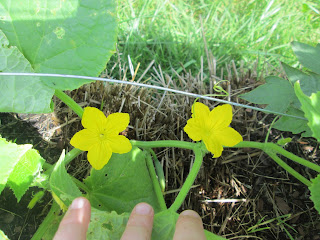June 5th through June 30th
I know that this is a late update, but hopefully it will also be a short update. Maybe that will help make up for it? :)
We would go out into the garden every morning we possibly could. Giraffe liked to pick the long, slender, slippery mushrooms that came up in the night.
You might think of fungus as a bad sign, but in reality it is a sign that the straw bales are well conditioned and ready to grow. Yay! :)
You can see the joy she takes in talking to and tending the little plants. :) Here she is communing with the tomatoes.
On the left side of this straw bale are our heirloom Abe Lincoln tomatoes. Hopefully, they will be large and juicy when they are fully grown.
On the right side are the tomatoes we picked up at the grocery store and liked so much we seeded and planted.
A week later on the 17th we had finally set up poles and started to run wire between them to support our growing plants. Admittedly we should have done this much sooner in the process. Next year it will be done immediately so the plants know where to grow.
The only plants outside of the wire/pole framework are the carrots. They do not need the support, so we did not provide it.
June 20th saw even more wires and more plant growth. It was also in the middle of a particularly rainy patch. In fact, the last half of June was so rainy that the month began to climb the record list. I believe it ended up being the 7th rainiest month in our state history. The garden benefitted greatly, as you can tell. We had the soaker hose out where it needed to be, but truthfully did not really end up needing to use it. :)
Around this time, Giraffe began to notice wee strawberries growing in the planter. :) This is always one of her favorite times of the year. She squeaks and squeals over each new berry, exclaiming about how pretty and precious they are. Funny... I think the same things about her! :)

The cucumber plants began to flower. These are staminate male flowers. They show up before the carpellate females. This is so their pollen attracts bees (etc).
By the time the females arrive, the cucumber plants are on the daily route of several pollinators - increasing the success rate of pollination and fruit production.
This year we have only noticed a single honeybee in our yard. Last year we had just four. This year only one, and he nearly drowned in the pool. Thankfully we saved him in time. We have plenty of wasps, but they honey bees are disappearing. Why do I mention it?
This is tragic proof of the mass die-off that has been taking place.
Honey bees are vital to the pollination and success of plant growth, from flowers to home gardens like ours, to massive fields of America's life-sustaining crops. Companies like Monsanto are messing with the foods you consume every day. Their GMO's and pesticides are highly suspected to be behind the mass die-off that the honey bee colonies are facing.
Look it up, friends. This is a real problem. It is not just dangerous to honeybees, it is dangerous to us. Food brought to you by the same companies who created Agent Orange. Look it up. Learn, research, and then find out what you can do to help stop this tragedy. If Obi Wan (hubs) and the HOA were okay with it, Giraffe and I would start bee keeping tomorrow.
June 20th saw the flowering and growth of our green beans, as well. I planted too many of these too close together. Oddly enough, they don't seem to mind the proximity of their neighbors and are doing very well.
June 22nd was the last time I took photos for the month. I briefly lost my camera after that, thanks to Koala. :) I have only this final photo to share.
Tomato flowers, like other plants, contain pollen. Other plants carry their pollen on the outside of stamen growing one each inside of male flowers. Tomatoes have anthers instead of stamen: hollow tubes which have pollen inside. These anthers require vibration in order to release the pollen, which then sticks to the stigma. From there, the pollen grains grow tubes to the seeds and fertilize them. It is a fascinating process!
Usually, the vibration of bees is enough to accomplish this. Even the soft brush of the wind can accomplish this (although not to great effect). The more seeds that are fertilized, the more fleshy the fruit. Humans have taken to providing vibration in a variety of ways to ensure good fruit production. One might 'spank' the tomatoes (as you can see Giraffe doing here) to provide vibration in the stems. You could also hold a vibrating toothbrush against the stems, or tape a pencil lightly against them. Mind you, this is never done hard enough to damage any part of the plant at any time.
There you have it! :) We have caught up on updating the 2015 straw bale garden effort for the month of June! :)








No comments:
Post a Comment
Please Share Your Thoughts Here